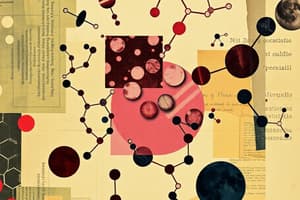Podcast
Questions and Answers
What type of compound are lipids?
What type of compound are lipids?
organic
What three elements are lipids composed of?
What three elements are lipids composed of?
carbon, hydrogen, and oxygen
Lipids are large complex molecules called?
Lipids are large complex molecules called?
macromolecules
Why are lipids non-polar molecules?
Why are lipids non-polar molecules?
What property does being non-polar lead to?
What property does being non-polar lead to?
What are triglycerides?
What are triglycerides?
What is glycerol?
What is glycerol?
Glycerol is an alcohol that contains 3 carbon atoms joined by a?
Glycerol is an alcohol that contains 3 carbon atoms joined by a?
What happens when the hydroxyl group between the glycerol and fatty acid interact?
What happens when the hydroxyl group between the glycerol and fatty acid interact?
What is this reaction called?
What is this reaction called?
What is the bond called formed during esterification?
What is the bond called formed during esterification?
What type of reaction is esterification an example of?
What type of reaction is esterification an example of?
What is the formula of glycerol?
What is the formula of glycerol?
What is this particular glycerol's modern chemical name?
What is this particular glycerol's modern chemical name?
What is the general formula of a fatty acid?
What is the general formula of a fatty acid?
What group of molecules do fatty acids belong to?
What group of molecules do fatty acids belong to?
Why are fatty acids called acids?
Why are fatty acids called acids?
What happens to the carboxyl group when in water?
What happens to the carboxyl group when in water?
Give the equation for the dissociation of the carboxyl group.
Give the equation for the dissociation of the carboxyl group.
What is the rest of the fatty acid composed of?
What is the rest of the fatty acid composed of?
How can the hydrocarbon chain vary in fatty acids?
How can the hydrocarbon chain vary in fatty acids?
What gives a fatty acid its properties?
What gives a fatty acid its properties?
When is a triglyceride formed?
When is a triglyceride formed?
What is this reaction called?
What is this reaction called?
What is removed and what is formed during triglyceride formation?
What is removed and what is formed during triglyceride formation?
What is the umbrella term used to describe triglycerides?
What is the umbrella term used to describe triglycerides?
How are triglycerides grouped?
How are triglycerides grouped?
What are triglycerides called when liquid at room temperature (20 degrees C)?
What are triglycerides called when liquid at room temperature (20 degrees C)?
What are triglycerides called when solid at room temperature?
What are triglycerides called when solid at room temperature?
What is each molecule of fat or oil made up of?
What is each molecule of fat or oil made up of?
Fatty acids can be described as?
Fatty acids can be described as?
What does saturated mean?
What does saturated mean?
Saturated fatty acids have only?
Saturated fatty acids have only?
Explain the link between saturated triglycerides and the appearance of fats.
Explain the link between saturated triglycerides and the appearance of fats.
Name an example of an unsaturated fat.
Name an example of an unsaturated fat.
What are fatty acids with one double bond called?
What are fatty acids with one double bond called?
What are fatty acids with more than one double bond called?
What are fatty acids with more than one double bond called?
What are the 2 arrangements around a double bond called?
What are the 2 arrangements around a double bond called?
Triglycerides with a high proportion of cis-fatty acids tend to be what at room temperature?
Triglycerides with a high proportion of cis-fatty acids tend to be what at room temperature?
What does the presence of one or more double carbon-carbon bonds cause?
What does the presence of one or more double carbon-carbon bonds cause?
Why are fats a more concentrated source of energy than protein and carbohydrates?
Why are fats a more concentrated source of energy than protein and carbohydrates?
In mammals, what is extra fat laid down for?
In mammals, what is extra fat laid down for?
What are phospholipids?
What are phospholipids?
What elements do phospholipids contain?
What elements do phospholipids contain?
Where are inorganic phosphate ions found in every cell?
Where are inorganic phosphate ions found in every cell?
Why are phosphate ions negatively charged?
Why are phosphate ions negatively charged?
What property does being negatively charged lead to?
What property does being negatively charged lead to?
Why are phospholipids called surfactants?
Why are phospholipids called surfactants?
What is a bilayer and how is it formed?
What is a bilayer and how is it formed?
What is another name for sterols?
What is another name for sterols?
Where are steroids found?
Where are steroids found?
Steroids are not?
Steroids are not?
What is the complex alcohol structure based on?
What is the complex alcohol structure based on?
What do steroids of phospholipids have in common?
What do steroids of phospholipids have in common?
Name a sterol.
Name a sterol.
Where is cholesterol manufactured in the body?
Where is cholesterol manufactured in the body?
What is cholesterol's important role?
What is cholesterol's important role?
Name 3 things manufactured using cholesterol.
Name 3 things manufactured using cholesterol.
Due to their non-polar nature, name 4 biological roles of lipids.
Due to their non-polar nature, name 4 biological roles of lipids.
What are lipids (in particular triglycerides) roles around organs and under the skin?
What are lipids (in particular triglycerides) roles around organs and under the skin?
What laboratory test is used to determine if lipids are present?
What laboratory test is used to determine if lipids are present?
Method for emulsion test.
Method for emulsion test.
Flashcards
Lipids
Lipids
Organic compounds primarily composed of carbon, hydrogen, and oxygen, with a lower oxygen content compared to carbohydrates.
Macromolecules
Macromolecules
Large, complex molecules with a variety of biological functions.
Non-polar molecules
Non-polar molecules
Molecules that repel water due to an even distribution of electrons.
Triglyceride
Triglyceride
Signup and view all the flashcards
Glycerol
Glycerol
Signup and view all the flashcards
Esterification
Esterification
Signup and view all the flashcards
Fatty acids
Fatty acids
Signup and view all the flashcards
Saturated fatty acids
Saturated fatty acids
Signup and view all the flashcards
Unsaturated fatty acids
Unsaturated fatty acids
Signup and view all the flashcards
Oils
Oils
Signup and view all the flashcards
Fats
Fats
Signup and view all the flashcards
Phospholipids
Phospholipids
Signup and view all the flashcards
Hydrophilic head
Hydrophilic head
Signup and view all the flashcards
Hydrophobic tail
Hydrophobic tail
Signup and view all the flashcards
Surfactants
Surfactants
Signup and view all the flashcards
Sterols (Steroid alcohols)
Sterols (Steroid alcohols)
Signup and view all the flashcards
Cholesterol
Cholesterol
Signup and view all the flashcards
Emulsion test
Emulsion test
Signup and view all the flashcards
Emulsion layer
Emulsion layer
Signup and view all the flashcards
Lipids as membrane components
Lipids as membrane components
Signup and view all the flashcards
Lipids as hormone precursors
Lipids as hormone precursors
Signup and view all the flashcards
Lipids for nerve insulation
Lipids for nerve insulation
Signup and view all the flashcards
Lipids for waterproofing
Lipids for waterproofing
Signup and view all the flashcards
Lipids for thermal insulation
Lipids for thermal insulation
Signup and view all the flashcards
Lipids for organ cushioning
Lipids for organ cushioning
Signup and view all the flashcards
Lipids for buoyancy
Lipids for buoyancy
Signup and view all the flashcards
Study Notes
Lipids Overview
- Lipids are organic compounds primarily composed of carbon, hydrogen, and oxygen, with less oxygen than carbohydrates.
- They are classified as macromolecules, indicating their large, complex structure.
Properties of Lipids
- Lipids are non-polar molecules due to the even distribution of electrons, leading to insolubility in water.
- The non-polar nature of lipids contributes to their biological functions.
Triglycerides
- Triglycerides consist of one glycerol molecule and three fatty acids.
- Glycerol is a small alcohol with three carbon atoms connected by hydroxyl groups.
- Esterification is the reaction forming triglycerides, where three water molecules are produced and ester bonds are formed.
Fatty Acids
- Fatty acids are carboxylic acids characterized by the general formula CH3(CH2)nCOOH.
- They include hydrocarbon chains which vary in length, degree of saturation (single or double bonds), and position of double bonds.
- Saturated fatty acids contain only single bonds, while unsaturated fatty acids have one (mono-unsaturated) or more (polyunsaturated) double bonds.
Physical States of Triglycerides
- Triglycerides are categorized as oils when liquid at room temperature and fats when solid.
- The structure of saturated triglycerides allows tight packing, making them solid, while unsaturated triglycerides tend to be liquid due to kinks in their structure from double bonds.
Phospholipids
- Phospholipids are modified triglycerides containing carbon, hydrogen, oxygen, and phosphorus.
- They form bilayers in cell membranes due to the hydrophilic heads and hydrophobic tails, acting as surfactants.
Sterols
- Sterols, also known as steroid alcohols, have a complex structure based on a four-carbon ring with hydroxyl groups.
- Cholesterol is a key sterol manufactured in the liver and intestines, essential for cell membrane formation and the synthesis of Vitamin D, steroid hormones, and bile.
Biological Roles of Lipids
- Lipids play critical roles including:
- Formation of membranes and hydrophobic barriers.
- Production of hormones.
- Providing electrical insulation for nerve transmission.
- Waterproofing surfaces in animals and plants.
- In mammals, lipids serve as thermal insulation, cushioning for vital organs, and buoyancy for aquatic species.
Testing for Lipids
- The emulsion test is used to detect the presence of lipids, involving mixing the sample with ethanol followed by water, leading to an emulsion layer if lipids are present.
Studying That Suits You
Use AI to generate personalized quizzes and flashcards to suit your learning preferences.




